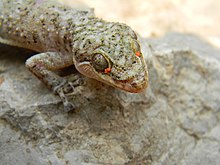The yellowbelly gecko (Phyllodactylus tuberculosus) is a species of gecko, a lizard in the family Phyllodactylidae. The species is native to Mexico and Central America. There are two recognized subspecies.[2]
| Yellowbelly gecko | |
|---|---|

| |
| Scientific classification | |
| Domain: | Eukaryota |
| Kingdom: | Animalia |
| Phylum: | Chordata |
| Class: | Reptilia |
| Order: | Squamata |
| Family: | Phyllodactylidae |
| Genus: | Phyllodactylus |
| Species: | P. tuberculosus
|
| Binomial name | |
| Phyllodactylus tuberculosus Wiegmann, 1834
| |
Geographic range
editP. tuberculosus is found in the southern Mexican states of Guerrero, Michoacán, Morelos, and Quintana Roo, and in the Central American countries of Belize, Costa Rica, El Salvador, Guatemala, Honduras, and Nicaragua.[1][2]
Habitat
editThe preferred natural habitat of P. tuberculosus is forest, at altitudes from sea level to 1,300 m (4,300 ft). It also is found in houses, where it hides during the day inside walls and in thatch roofs.[1]
Behavior
editP. tuberculosus is terrestrial and predominately nocturnal.[1]
Diet
editReproduction
editSubspecies
editTwo subspecies are recognized as being valid, including the nominotypical subspecies.[2]
Etymology
editThe subspecific name, ingeri, is in honor of American herpetologist Robert F. Inger.[3]
References
edit- ^ a b c d e f Chaves, G.; Flores-Villela, O.; Lamar, W.; Porras, L.W. (2013). "Phyllodactylus tuberculosus ". IUCN Red List of Threatened Species. 2013: e.T198394A2524461. doi:10.2305/IUCN.UK.2013-2.RLTS.T198394A2524461.en. Retrieved 18 November 2021.
- ^ a b c d Phyllodactylus tuberculosus at the Reptarium.cz Reptile Database
- ^ Beolens B, Watkins M, Grayson M (2011). The Eponym Dictionary of Reptiles. Baltimore: Johns Hopkins University Press. xiii + 296 pp. ISBN 978-1-4214-0135-5. (Phyllodactylus tuberculosus ingeri, p. 129).
Further reading
edit- Grismer LL, Grismer MS (1987). "Phyllodactylus tuberculosus. Distribution." Herpetological Review 18: 40.
- Ramírez-Reyes T, Flores-Villela O, Piñero D, Lathrop A, Murphy RW (2021). "Genomic assessment of the Phyllodactylus tuberculosus complex (Reptilia: Phyllodactylidae) in America". Zoologica Scripta 50 (5): 529–542.
- Savage JM (2002). The Amphibians and Reptiles of Costa Rica: A Herpetofauna between Two Continents, between Two Seas. Chicago and London: University of Chicago Press. xx + 945 pp. ISBN 0-226-73537-0.
- Wiegmann AFA (1834). "Beiträge zur Zoologie, gesammelt auf einer Reise um die Erde. Siebente Abhandlung. Amphibien ". Verhandlungen der Kaiserlichen Leoplodinisch-Carolinischen Akademie der Naturforscher. Nova Acta Physico-Medico, Academiae Caesare Leopoldino-Carolinae 17 (1): 185–268 + Plates XIII–XXII. (Phyllodactylus tuberculosus, new species, p. 241). (in German and Latin).
